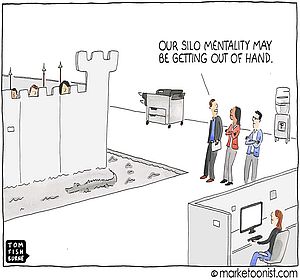| Excerpt from www.NDMA.COM, © 2025 N. Dean Meyer and Associates Inc.
Analysis: The "Silo" Organization
giving up on the synergies of being one organization
by N. Dean Meyer
[excerpt from the book, Principle-based Organizational Structure]
Some leaders believe that the only way you can get people to work well together is to put them under a common boss, who presumably will form teams and force staff to cooperate. Citing the Golden Rule, they add that to hold managers accountable for results, you've got to give them authority over all the needed resources. Essentially, they accept the current, limited teaming capabilities of their organizations, and design the structure to minimize interdependencies and "hand offs." They put all the skills needed by a function under its manager. This is sometimes called the "silo" organization, since it's made up of groups that are self-sufficient and don't need to work together all that much -- like a bunch of vertical silos that never touch.
A Manufacturing ExampleIn manufacturing, the production line has to be scheduled based on demand; and just the right raw materials have to show up at just the right time.
In a rapidly growing food company, this wasn't working well. Production managers did their job. Supply-chain managers did theirs. But their schedules weren't meshing. To get them to work together, the Chief Operating Officer appointed a "facilities manager" for each of their three production locations. Reporting to each was a production manager and a supply-chain manager. The job of the facilities managers was to ensure that scheduling and production worked well together. Things did work better. But while solving one problem, this structure created many more.
The ResultsIn a silo organization, each profession is scattered among the various groups that need it. This fragmentation reduces specialization, because each member of that profession within each silo must cover the entire profession. The result is lower performance; the benefits of specialization are lost.
Exacerbating this lack of depth in their fields, best-practices in one facility weren't applied to the others. Furthermore, the company lost global buying power. Perhaps the most costly result was this: he company was no longer able to manage its production capacity globally. One plant could be overwhelmed while another worked below capacity. By depending on direct supervision to create teamwork, this company gave up the synergies across manufacturing facilities that were critical to competitive advantage.
AlternativeYou don't need to build silo structures to match authorities to accountabilities. Doing so is like saying that you need to own your own grocery store to control what you eat! Just as managers have authority over external vendors, they can manage team-members in other groups who are assigned to them. And you don't need managers of silos to force people to collaborate. The antidote to silos is effective teamwork across boundaries.
|


